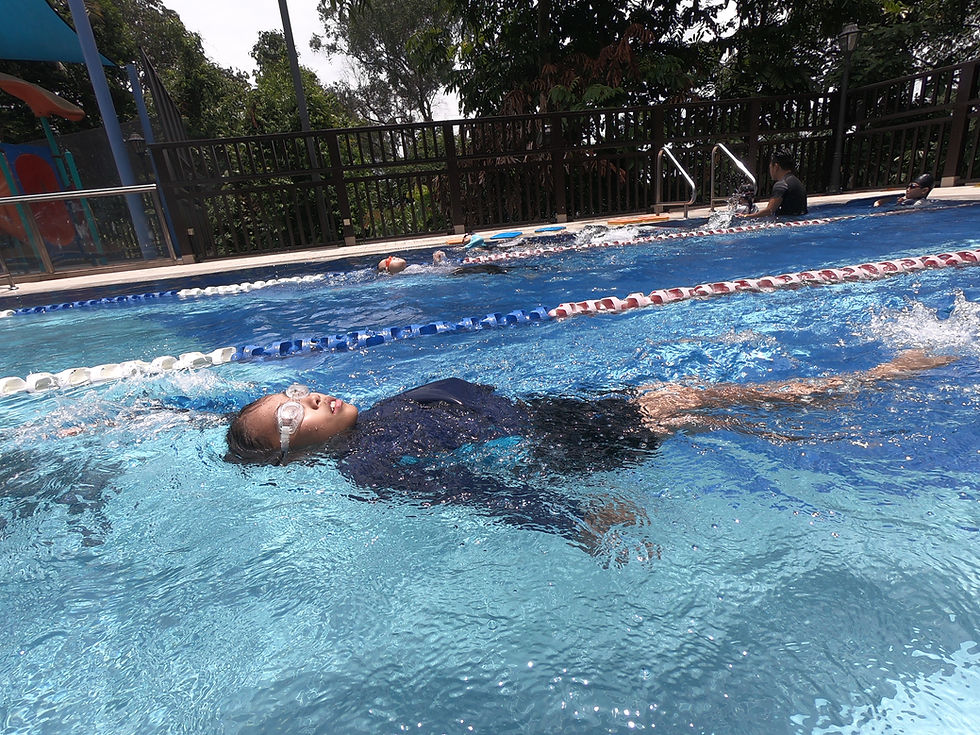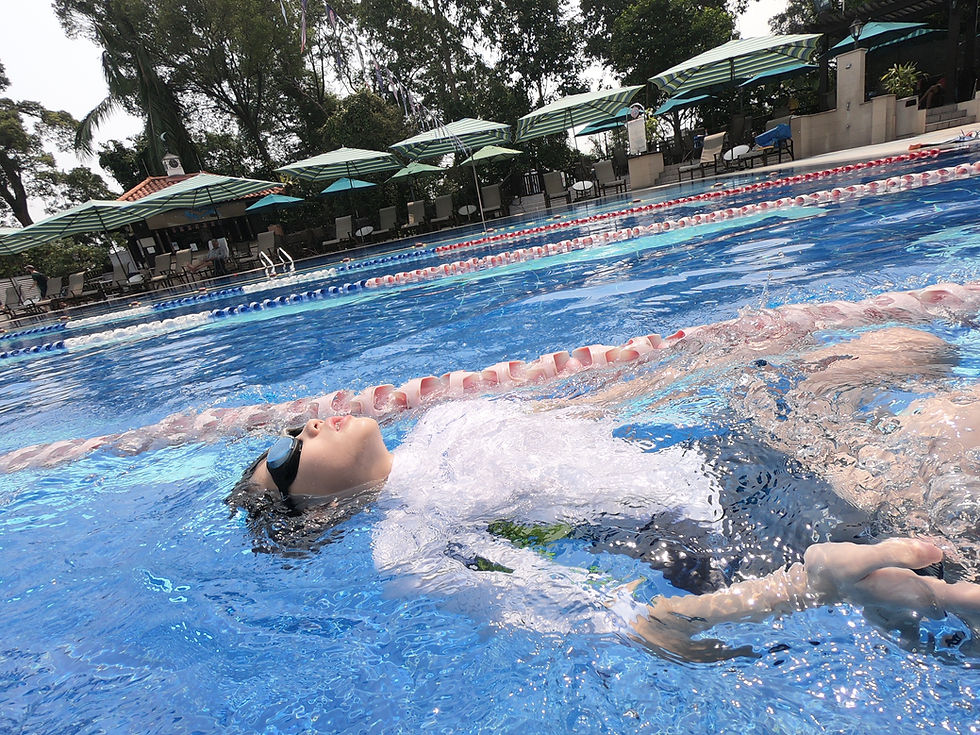Self-Taught Backstroke: Training for Competitive Excellence
- SG Sink Or Swim

- 4 days ago
- 5 min read

How to Master the “Rest Stroke” — Without a Coach, Without Limits
Backstroke is often called the “rest stroke” — but for those who swim it competitively, it’s anything but easy. It demands precision, rhythm, core strength, and flawless timing. And yet, for many swimmers — especially adults, triathletes, or those without access to elite coaching — learning backstroke on their own isn’t just possible… it’s the path to excellence.
You don’t need a coach to become a fast, efficient, and competitive backstroker. You need discipline, self-awareness, and a strategic plan.
In this guide, we’ll show you how to train like a champion — entirely on your own — using proven techniques, free tools, and smart progression to develop a backstroke that’s not just fast, but race-ready.
🌊 Why Self-Taught Backstroke Is Not Only Possible — It’s Powerful
Many assume elite swimming requires years of structured coaching. But consider this:
Ryan Murphy, Olympic gold medalist, learned backstroke as a child by watching videos and practicing alone.
Masters swimmers regularly break age-group records without ever having a private coach.
Triathletes dominate open water swims using self-taught backstroke technique to conserve energy.
The secret? You don’t need someone telling you what to do — you need to know how to learn.
Self-teaching forces you to:
Observe critically
Analyze deeply
Problem-solve independently
Own your progress
These are the exact traits of elite athletes.
🧭 The 4 Pillars of Self-Taught Backstroke Excellence
1. Master the Fundamentals First — No Shortcuts
Before chasing speed, you must master the three pillars of backstroke:
Body Position | Flat, horizontal, hips high | Lie on back in shallow water — if your hips sink, you’re not aligned |
Body Rotation | 30–45° roll from hip to shoulder | Practice “6-kick switch” drill (see below) |
Kick | Small, fast, from hips — not knees | Do vertical kicking in deep water (no hands) |
🚫 Avoid: Swimming flat — it’s the #1 cause of drag and shoulder strain.
✅ Pro Tip: Film yourself from the side. Your body should look like a straight line from head to toes — not a banana.
2. Use Free Tools to Replace a Coach
You don’t need expensive gear. You need awareness and technology.
Smartphone + Waterproof Case | Film your stroke from side and front every 2 weeks. Compare to elite swimmers (e.g., Ryan Murphy, Kathleen Baker). |
Tempo Trainer (or Free Metronome App) | Set to 1.4–1.6s per stroke. Match your arm recovery to the beep. |
FORM Smart Goggles (Optional but powerful) | Tracks stroke count, SPM, and pace — ideal for self-analysis. |
YouTube | Search: “Ryan Murphy backstroke technique,” “backstroke flip turn tutorial,” “how to improve backstroke kick.” Watch, pause, mimic. |
Pace Clock | Use your phone timer or pool clock to time intervals and track improvement. |
3. Build a Self-Training Plan — No Guesswork
Structure is everything. Here’s a sample weekly plan for a self-taught competitive backstroker (aiming for 100m/200m races):
Monday | Technique & Rotation | 400m easy + 4x50m 6-kick switch + 4x50m single-arm backstroke |
Tuesday | Speed & Starts | 8x25m backstroke sprints (max effort) + 6x15m flip turn sprints |
Wednesday | Recovery & Mobility | 600m easy backstroke + foam roll hips, shoulders, thoracic spine |
Thursday | Endurance & Pacing | 5x200m @ race pace (use tempo trainer) — focus on even splits |
Friday | Turn & Breakout | 8x25m flip turns (focus on legal touch, streamline, 5 UDK) |
Saturday | Race Simulation | 1x100m time trial + 1x200m time trial (film both) |
Sunday | Rest or Cross-Train | Yoga, walking, or dryland core work |
💡 Total weekly yardage: ~4,500–6,000m — ideal for competitive development without burnout.
4. Track Progress — Because You Can’t Improve What You Don’t Measure
Self-taught swimmers succeed because they’re their own coaches. Track these metrics:
Stroke Count | Count strokes per 25m | Reduce from 18 → 15–16/25m at race pace |
Stroke Rate (SPM) | Use Tempo Trainer or count strokes in 10s x6 | 75–85 SPM for 200m |
Time Trials | Time 50m, 100m, 200m every 3–4 weeks | Drop 0.5–1.0s per month |
Underwater Distance | Mark pool floor — how far do you glide after flip turn? | 10–15m per wall |
Perceived Effort | Rate 1–10 after each set | Should decrease over time at same pace |
📊 Tip: Use a simple spreadsheet or app like MySwimPro to log your progress visually.
🔧 Essential Drills for Self-Taught Success
✅ 1. 6-Kick Switch (The Golden Drill)
Swim on your back, one arm extended, other at side
Take 6 kicks → switch arms → 6 kicks on other side
Focus: Rotate hips and shoulders as one unit — no twisting
Do 4 x 50m twice a week
🎯 Cue: “Roll like a log — not a noodle.”
✅ 2. Single-Arm Backstroke
One arm at side, other performs full stroke
Keep head still, eyes on ceiling
Breathe every 2–3 strokes
Do 4 x 50m per arm
🎯 Cue: “Let your shoulder lead — your arm follows.”
✅ 3. Flip Turn + 5 Dolphin Kicks
Push off wall in streamline
Execute a clean flip turn (touch with both hands while on back)
Do 5 powerful dolphin kicks before surfacing
Do 6–8 reps after every hard set
⚠️ Rule: Must touch wall while on back — no rolling early!
✅ 4. Tempo Trainer Sets
Set your device to 1.5s/stroke
Swim 4 x 100m, matching the beep
Focus: Smooth, even rhythm — no rushing or pausing
Progress: Drop to 1.4s as you improve
🎯 Cue: “The beep is your heartbeat — match it.”
✅ 5. Blind Sighting Drill
Swim 50m with eyes closed (have a partner nearby for safety)
Use stroke count to know when you’re approaching the wall
Builds internal rhythm and spatial awareness
💡 Perfect for open water swimmers — trains confidence without visual cues.
🚫 Common Self-Taught Mistakes — And How to Fix Them
Swimming flat | Creates drag, strains back | Film yourself — if hips sink, do 6-kick switch drills daily |
Kicking from knees | Wastes energy, causes injury | Do vertical kick drills — knees stay underwater |
Lifting head too high | Drops hips, breaks streamline | Practice with snorkel or “tennis ball under chin” drill |
No flip turns | Loses speed on every wall | Watch YouTube tutorials — practice 10x/day for 3 days |
Only swimming distance | No speed or technique gains | Add 1–2 speed sets per week — even 25m sprints |
💬 Mindset of a Self-Taught Champion
“I don’t need permission to improve.”
“My progress is my reward.”
“I don’t compare to others — I compare to my last self.”
“Every video I film is a lesson, not a judgment.”
“The best coaches aren’t in the pool — they’re in your mind.”
🏁 Final Thoughts: You Are Your Own Coach
You don’t need a team, a timeline, or a trophy to become a competitive backstroker.
You need:
Curiosity — to learn
Discipline — to practice
Patience — to improve
Courage — to film yourself, analyze, and try again
Backstroke isn’t about being the loudest or the fastest — it’s about being the most consistent, precise, and self-aware.
So grab your phone.Set your tempo trainer. Film your stroke.Repeat.
Because the water doesn’t care if you had a coach.
It only cares if you showed up —and kept learning.
Roll. Reach. Kick. Turn. Repeat.
Your fastest backstroke isn’t waiting for a coach —it’s waiting for you to take the first step. 💙🏊♂️





Comments